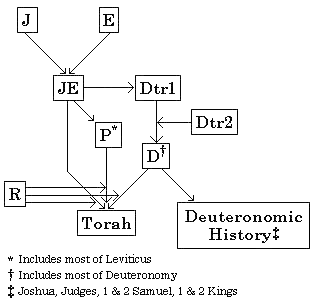Documentary hypothesis
The documentary hypothesis is an attempt to chart the origins and authorship of the Pentateuch and parts of the Deuteronomistic historical writings (The Books of Joshua, Judges, 1 & 2 Kings, and 1 & 2 Samuel). It was formulated in its "classical" form in the 1880s by the German theologian Julius Wellhausen on the basis of research done in the 17th and 18th centuries.[1]
| Light iron-age reading The Bible |
| Gabbin' with God |
|
| Analysis |
| Woo |
| Figures |
|
v - t - e |
The hypothesis
Briefly put, the documentary hypothesis posits that the Pentateuch has been assembled by various editors on the basis of four different sources, referred to respectively as J, E, D, and P.
- The J, or Jahwist source is mostly narrative. It is the oldest of the four, making up half of Genesis, the first half of Exodus, and parts of Numbers.
- The E, or Elohist source has much the same content as J, likewise making up about one third of Genesis, the first half of Exodus, and parts of Numbers.
- The D, or Deuteronomist source is mostly found in Deuteronomy, focusing on legal points and sermons.
- The P, or Priestly source contains the greater part of Leviticus, as well as parts of Genesis, Exodus and Numbers.
The four sources differ on a number of points, including age, content, literary style, and theology. These differences often make it possible to distinguish which parts of the Pentateuch come from which sources, and how they have changed through time.
According to the hypothesis, different editors have at times combined some of the sources or drawn upon each other to form intermediary sources, as shown in this figure:

The ultimate collection of the material in the Pentateuch is held to have happened around the middle of the 1st century BCE by the final editor, usually referred to as the Torah Redactor. There is no agreement on the identity of this figure.
An widely-used guide to the documentary hypothesis is Who Wrote the Bible? by Richard Eliot Friedman (originally 1987, reissued in 2019), [2] available in many public libraries.
Analysis
The documentary hypothesis soon gained widespread recognition. Until about the mid-1960s, it was substantially accepted by the vast majority of biblical scholars, with the exception of professors in conservative sectarian institutions, who typically held (and still hold) Moses as the author of the Pentateuch.
In recent decades, this consensus has mostly disappeared, as a number of new theories that suggest both more and less complex origins for the Pentateuch have appeared. However, the documentary hypothesis still stands as a central theory with a number of proponents, most prominently Richard Elliott Friedman, who writes.
The situation is not that the documentary hypothesis does not have a clear consensus of Bible scholars. It is that no hypothesis has a clear consensus of Bible scholars. The documentary hypothesis is just what it says: the Hebrew Bible is made up of documents, of source texts that editors (redactors) put together in several stages. That is the central idea, and nearly all scholars known to me outside of orthodox or fundamentalist communities are persuaded by that idea. The point about consensus is that we are now getting a profusion of variations of this central idea. [3]
The current situation has been playfully called the "PostIt Notary Hypothesis" (i.e., a micro-documentary hypothesis). One scenario is that scribes added notes in the margins of papyrus, and when the papyrus of the master copy wore out, the notes could the incorporated into the text of the new master copy. As Isaiah 65:17 confidently says, "the former things shall not be remembered or come to mind." At present no usage experiments have been conducted to determine the average lifespan of a papyrus scroll in the Jerusalem climate under supposed conditions of "normal use"; such data would help suggest how often new versions of the master copy were made.
A recent work presenting the hypothesis for college undergraduates and graduate students isThe Composition of the Pentateuch: Renewing the Documentary Hypothesis by Joel S. Baden of Yale Divinity School.[4] He argues for the continuity of the J-source, the coherence of the E-source, the unity of the D-source (not a legal document and a historical narrative that were later combined, but already interwoven when first included in the Pentateuch), and the completeness of the P-source (it is not a series of separate editorial decisions by a plurality of priestly editors).[5]
Bibliography
- Friedman, Richard E.: Who Wrote The Bible? (Harper and Row: New York, 1987)
- Wellhausen, Julius: Prolegomena To The History Of Israel (Berlin, 1882)
See also
- Biblical criticism
- Q gospel – a different multi-authorship issue but in the New testament
External links
- Wikiversity: Bible, English, King James, According to the documentary hypothesis contains the KJV text of the Pentateuch color-coded according to one version of the documentary hypothesis. On this site, it is also possible to read each document independently.
- Free ebook version of Wellhausen's Prolegomena To The History Of Israel at Project Gutenberg.
References
- Wellhausen, Julius 1882. Prolegomena zur Geschichte Israels
- Friedman, Richard. Who wrote the Bible?. Simon and Schuster, 2019.
- Richard Elliot Friedman (2017), "The Exodus: How It Happened And Why It Matters," (HarperOne), p. 44.
- Baden, Joel S. (2012). The Composition of the Pentateuch: Renewing the Documentary Hypothesis. Yale University Press. ISBN 9780300152630.
- Erisman, Angela Roskop (2012). "A Literary Solution to a Literary Problem?". H-Net Reviews. Retrieved 8 July 2020. .